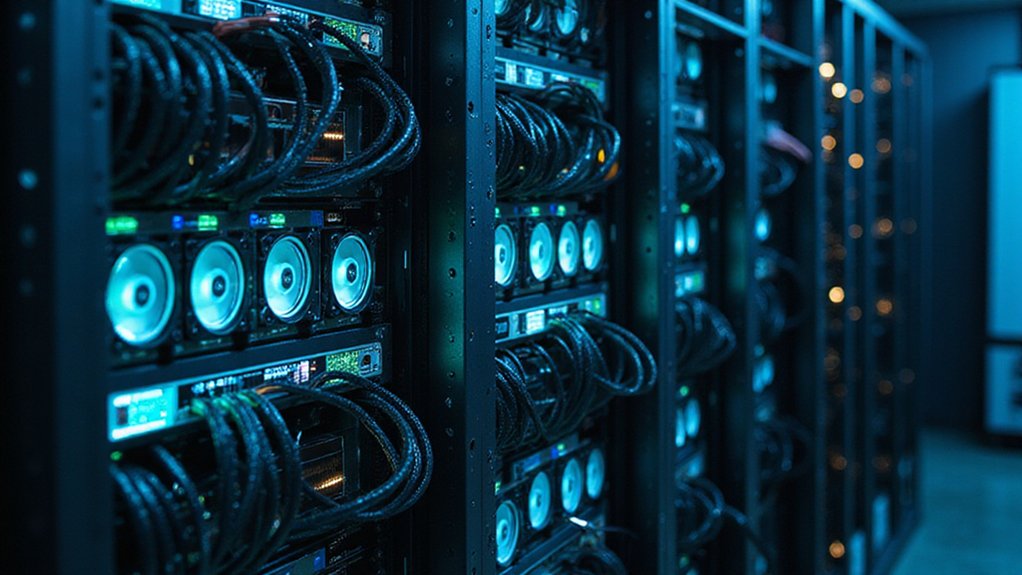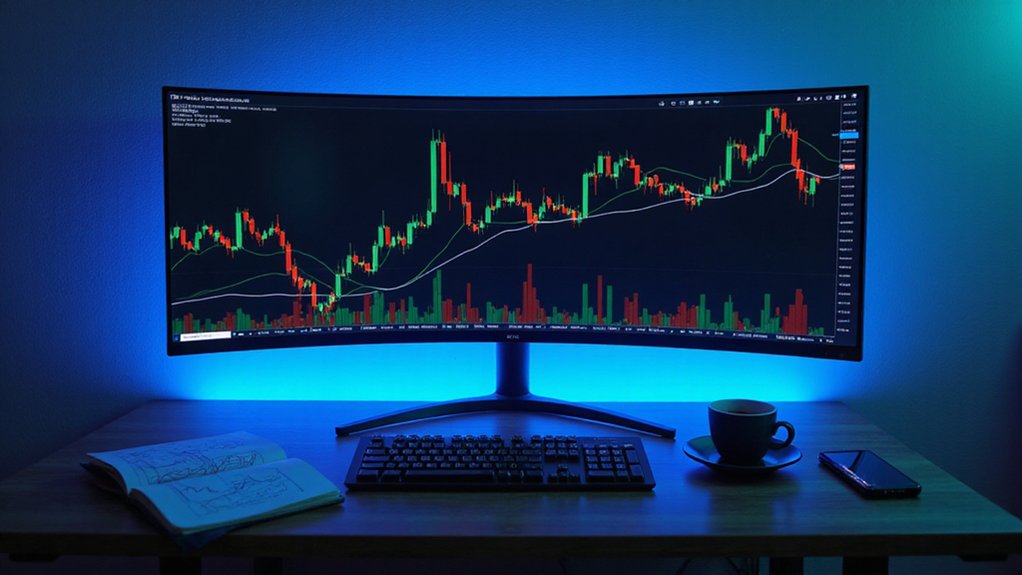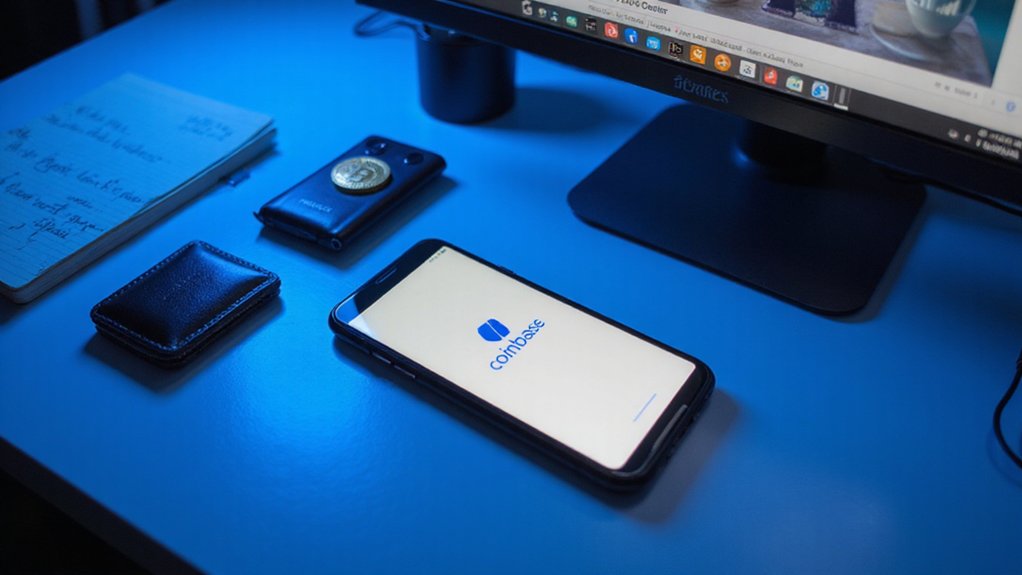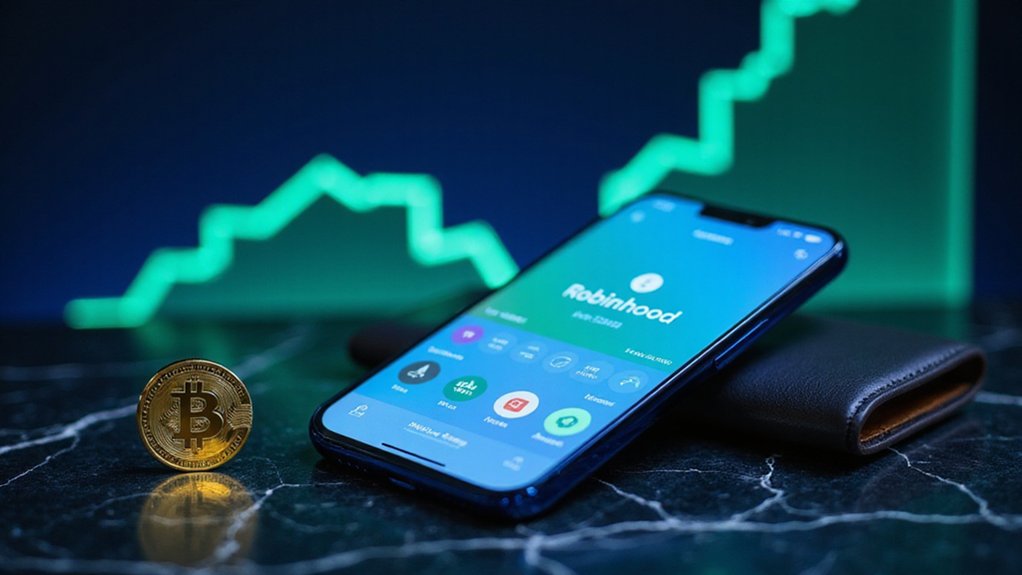Bitcoin mining employs specialized computers to solve cryptographic puzzles, basically a high-stakes mathematical lottery where miners compete to validate transactions and add them to the blockchain. The victorious miner receives newly minted bitcoins plus transaction fees—a clever incentive structure maintaining network security without central oversight. This computational arms race, once accessible to hobbyists with ordinary laptops, now requires power-hungry ASIC machines consuming electricity at national scales. The complexities behind this digital gold rush extend far beyond these surface mechanics.
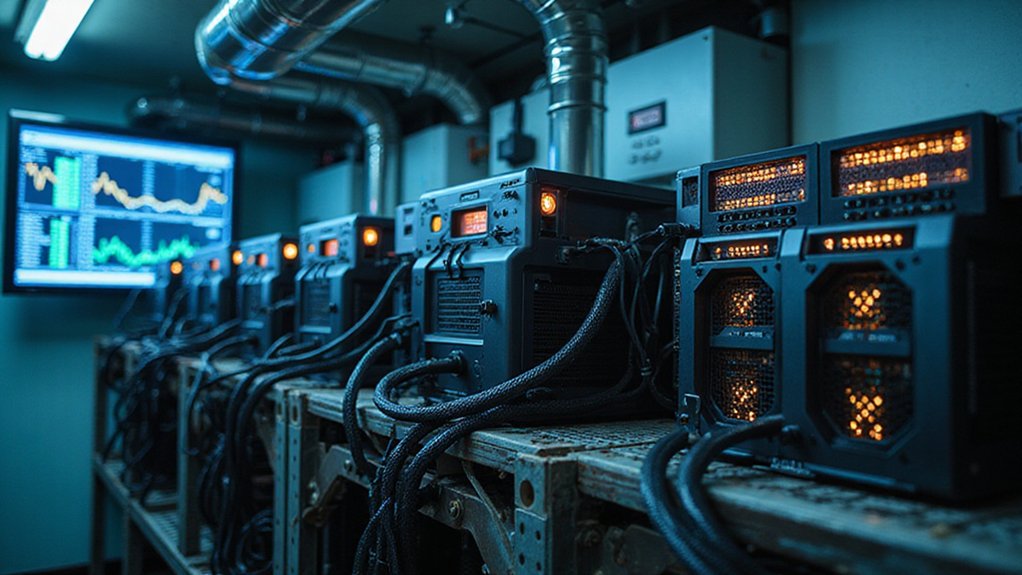
How exactly does digital currency materialize from the ether of cyberspace?
Bitcoin mining—a process more akin to computational prospecting than traditional excavation—involves validating transactions and adding them to a decentralized ledger known as the blockchain.
This arcane ritual, performed by armies of specialized computers, functions as both currency issuance mechanism and network security protocol—an elegant solution to the otherwise intractable problem of trust in a trustless system.
The mining process begins when transactions accumulate in the “mempool” (a digital waiting room of sorts), where miners gather them for inclusion in the next block. First miners who successfully complete the validation process receive Bitcoin rewards for their efforts.
The digital queue where Bitcoin transactions await their turn to be etched permanently into blockchain history.
These digital accountants then hash these transactions together to create a single Merkle root—a cryptographic fingerprint representing all transactions in the block.
What follows is perhaps the most resource-intensive digital wild goose chase ever devised: solving complex cryptographic puzzles through brute computational force.
Miners deploy specialized hardware—primarily Application-Specific Integrated Circuits (ASICs)—that perform quintillions of calculations per second in an attempt to find a nonce value that, when combined with block data and hashed, produces an output with a specific number of leading zeros.
This Proof-of-Work system, while seemingly wasteful, guarantees network security by making attacks prohibitively expensive.
Successful miners receive dual compensation: newly minted bitcoins and transaction fees from users seeking expedited processing.
This economic incentive structure—the invisible hand of Nakamoto, if you will—maintains network security without central coordination.
The difficulty of these cryptographic puzzles adjusts automatically every 2,016 blocks, guaranteeing consistent ten-minute block creation intervals regardless of aggregate computational power.
The hashing algorithms used in this process are designed to be computationally challenging to solve but easy to verify, ensuring the integrity of the blockchain network.
The environmental implications of this digital alchemy are substantial.
Bitcoin mining consumes electricity on par with small nations, prompting justified criticism and stoking regulatory concerns.
The block reward halving occurs approximately every four years, reducing the number of new bitcoins created and effectively making the cryptocurrency more scarce over time.
Some operations have migrated toward renewable energy sources, though sustainability remains elusive in an industry where margins depend heavily on electricity costs.
As the reward for mining halves approximately every four years (a deflationary mechanism baked into Bitcoin’s code), miners increasingly rely on transaction fees for revenue—a shift with profound implications for Bitcoin’s long-term economic model.
Frequently Asked Questions
What Are the Environmental Impacts of Bitcoin Mining?
Bitcoin mining’s environmental footprint is substantial—and increasingly problematic.
The process consumes vast electricity (largely fossil-fuel derived), generating significant CO2 emissions that could undermine Paris Agreement targets.
Beyond carbon concerns, mining operations contribute to air pollution through PM2.5 emissions, strain local water resources for cooling systems, and generate electronic waste from rapidly obsolete hardware.
As cryptocurrency adoption expands, these environmental externalities have attracted regulatory scrutiny worldwide, with projections suggesting crypto mining could represent 0.7% of global emissions by 2027.
How Much Can I Earn From Mining Bitcoin Today?
Bitcoin mining profitability today depends on several interconnected variables—hardware efficiency (ASIC models like the Antminer S21 being state-of-the-art), electricity costs (which, surprisingly, can constitute upwards of 90% of operational expenses), and current BTC market valuations.
For individual miners, returns have become vanishingly small; most profitable operations now require industrial-scale setups in regions with electricity costs below $0.05/kWh.
Mining calculators¹ offer personalized estimates based on one’s specific parameters.
¹These calculators factor in difficulty adjustments, which—rather inconveniently—tend to increase over time.
Do I Need Special Skills to Start Mining Bitcoin?
Bitcoin mining requires no specialized credentials per se, though several competencies prove indispensable: basic technical literacy (particularly regarding blockchain fundamentals), hardware understanding (ASICs aren’t exactly household appliances), and financial acumen to navigate profitability calculations.
The contemporary mining landscape favors those with capital resources and access to low-cost electricity rather than technical virtuosos.
Most beginners find themselves confronting a steep learning curve coupled with substantial initial investments—hardly the digital gold rush many envision.
Is Bitcoin Mining Legal in All Countries?
Bitcoin mining’s legality varies greatly worldwide, with some jurisdictions embracing it while others impose outright bans.
China particularly prohibits mining operations (a rather dramatic reversal of its former dominance in the sector), whereas countries like Georgia offer tax incentives.
The regulatory landscape remains in flux, influenced by concerns ranging from energy consumption to financial stability.
Even in countries where mining isn’t explicitly prohibited, miners must navigate a complex web of tax regulations and environmental restrictions that continues to evolve.
What Happens to Bitcoin Mining After All Coins Are Mined?
When Bitcoin’s 21 million coin limit is reached (projected around 2140), mining operations won’t simply vanish into the digital ether.
Miners will shift from block rewards to subsisting entirely on transaction fees—a paradigm shift in their economic incentive structure.
Network security will still depend on miners’ computational prowess, though profitability calculations will fundamentally change.
The resulting landscape may favor larger operations with scale economies, potentially increasing centralization—an ironic twist for a system predicated on decentralization’s virtues.
